
Product test
Omnana’s Glue yoga mat: how non-slip is it really?
by Anika Schulz

Rope skipping is not just for boxers. Training with a rope is said to be twice as effective as jogging. The demands on the body and the equipment are enormous, so the right fitness mat is a must, otherwise the risk of injury is high.
This spring, I caught rope skipping fever. The intensive cardio in a confined space and the ability to train anytime and anywhere are ideal for me. In the warmer months, I always trained outside. Now I move my training with the "Seiligumpi" indoors. It makes a lot of noise on the bare floor in the flat and also damages the parquet floor - not ideal in my rented flat.
To avoid upsetting my neighbours and landlord, I use my fitness mat for jumping indoors. The problem: although my old mat is sufficient for my calisthenics exercises, it always slips during workouts that involve a lot of movement, such as jumping rope. That's why I'm looking for the best mat for rope skipping at Galaxus.
I list the mats below according to ranking. The clear test winner is the one from Blackroll.
Thanks to its high weight and chequered underside, the Blackroll mat almost melts into the floor. It lies flat and doesn't slip at all. This applies to my parquet and tiled floor as well as the virgin wool carpet on which I tested the mat. Unfortunately, I wasn't able to test it on fitted carpet and laminate, but I think the mat holds up just as well here.
The surface also offers excellent grip. When jumping forwards and backwards, onto the sides or double unders, I have very good grip and feel secure.
The cushioning is also brilliant. When I land with my feet on the mat after a jump, it cushions comfortably without me sinking too deep. The rope swings nicely. It doesn't slow down, which would be a problem with double unders, for example, and at the same time it doesn't bounce up.
At 2.5 kilograms, the Blackroll is rather heavy. However, it can be rolled up compactly. Nevertheless, I find it only suitable for travelling to a limited extent due to its weight.
The mat rolls out nicely and lies flat. Thanks to its high dead weight and the material, the mat does not slip on parquet, tiles or my new wool carpet.
The mat also offers good grip when jumping, but I have the impression that it is even better on the Blackroll. Nevertheless, I never slipped during the test.
The cushioning is similar to that of the Blackroll: Not too hard and not too soft, perfect for jumping rope. However, I have the impression that the coarser surface structure of the Harmony slows the rope down a little more. I notice this especially with double unders.
Because of its relatively high weight, the same applies to the Harmony as to the Blackroll: You don't really want to carry it around with you for long. However, the four centimetres less in width make it a little more comfortable to carry. Like the Blackroll, the Harmony rolls up compactly and stays in this shape.
The mat rolls out flat, which favours grip. Due to its high weight, it can be assumed that it adheres well. However, this is only the case to a limited extent; the mat slips easily when jumping to the side and forwards and backwards. This applies equally to parquet, tiles and virgin wool carpet.
As long as the mat remains dry, the grip is very good when jumping. As soon as it gets a little sweat on it, it can become slippery. I recommend wiping away any drops of sweat immediately during training. Surprising, as the mat can actually also be used in water.
The mat absorbs very well, but too much for jumping rope. My feet sink in quite far, which I find annoying and takes the speed out of my jumps. The foam also slows down the rope as soon as it hits the material.
The mat is huge and heavy. As you can imagine, it is not at all practical for travelling.
As the mat is very light and does not roll up perfectly due to the material - one end always remains slightly rolled - I was initially concerned that the mat would not provide enough grip. Compared to the Blackroll and Harmony, the cork doesn't stick as well to parquet floors, tiles and virgin wool carpet, but it only slips minimally - even during intensive rope jumping.
The feet stick amazingly well to the cork. I feel secure when I land on the mat. However, the slight movements of the product itself spoil this good feeling again.
At 4 millimetres, the cork doesn't offer much room for cushioning. Training on it is therefore hard, it bounces less than the Harmony or the Blackroll. As a result, the rope bounces a little more and I have to adjust the height of my jumps.
The mat is quite light at 800 grams. However, it can't be rolled up as compactly as the Blackroll or Harmony. You shouldn't roll it up too tightly anyway, otherwise it will take some time to unroll and lie flat on the floor. This means that the cork is not the ultimate mobility mat tested.
At least the three mats score points for mobility: They are lightweight and the Tunturi and Pure2 Improve also come with a carrying strap. This is also necessary as the two mats would otherwise roll out by themselves.
From big data to big brother, Cyborgs to Sci-Fi. All aspects of technology and society fascinate me.
Practical solutions for everyday problems with technology, household hacks and much more.
Show all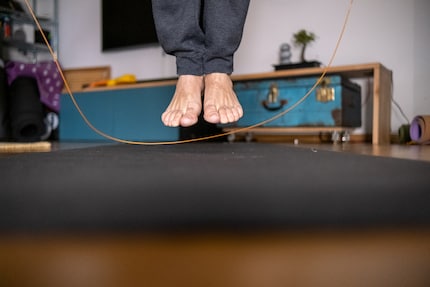
There are special mats for skipping rope, but we don't stock them at Galaxus. Not a big deal for me, as I need to replace my old, musty fitness mat anyway and I want to do my calisthenics workouts and stretching exercises on it as well as rope skipping. Pure rope skipping mats are usually not suitable for other workouts because they are too short. I get seven mats in different materials and sizes and test them for several weeks during my rope skipping workouts. These are the opponents:
I rate the mats according to the criteria of grip, cushioning and mobility. The most important criterion is grip. After all, the mat should stick to the ground and I shouldn't slip with my feet. Cushioning is very subjective, some like it softer, some harder. However, a mat for rope skipping should not have too much cushioning and also not too little, so that the rope neither brakes too much nor bounces when swinging through. If the mat is too soft, your feet sink too deeply into the material, which also takes speed out of the equation. Mobility is the least important topic for me, as I only use the mat indoors; I jump outside without a mat.
The Blackroll sports mat weighs 2.5 kilograms and, at 185 centimetres long and 65 centimetres wide, is slightly larger than most other fitness mats. At 5 millimetres thick, however, it is rather thin. The underside is chequered, which should provide better grip. The mat is made of rubber, but Blackroll does not specify exactly where this comes from. However, it is made from sustainable materials and is Oeko-Tex certified. You can read that this label is not beyond reproach in this article from Allnatura. At least you can be sure that the end product lying on your floor at home is not harmful to you. The item is manufactured in Germany. At just over 80 francs, the Blackroll is on the expensive side compared to the other mats tested.
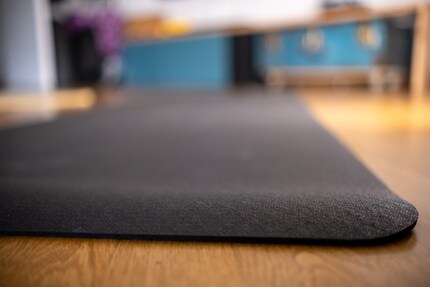
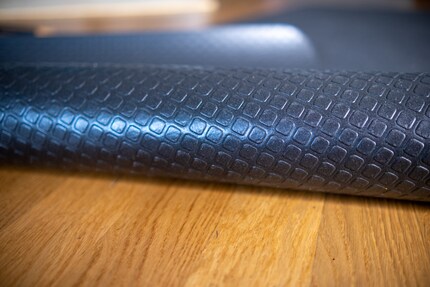
The Harmony from Jade Yoga has similar dimensions to the Blackroll sports mat: 188 centimetres long and 61 centimetres wide. At 5 millimetres thick, it is on the thick side for a yoga mat. At 2.4 kilograms, it is only 100 grams lighter than the Blackroll model. Like Blackroll, Jade Yoga also advertises sustainable materials such as natural rubber. The mat does not have a label, but a tree is planted for every mat sold. After all. The mat is manufactured in the USA. One of the few reasons why the Harmony only comes in second place is its width: the four centimetres less than the Blackroll make a huge difference when jumping on its side. At just under 90 francs, the mat is the second most expensive mat tested.
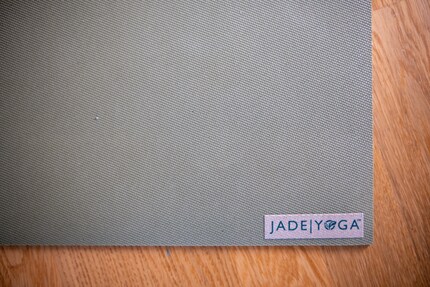
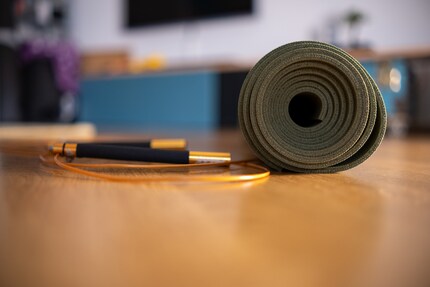
The mat with the somewhat unfortunate name in 2020 differs from the others above all in its dimensions. It measures two metres by one metre and is 15 millimetres thick. Its size is also reflected in its weight: at 4.1 kilograms, it is by far the heaviest mat. It is actually designed for therapy purposes, but can be used just as well for workouts. It can even be used in water. Not that I would want to, but it's good to know. The material is foam. At over 130 francs, the Corona is not only the largest of those tested, but also the most expensive. In return, you get a decent mat material that is made in Switzerland.
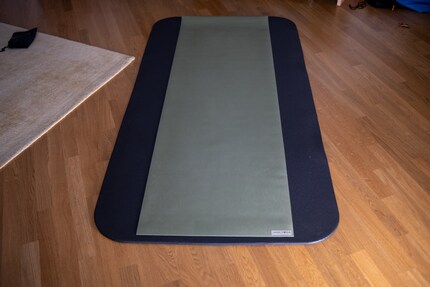
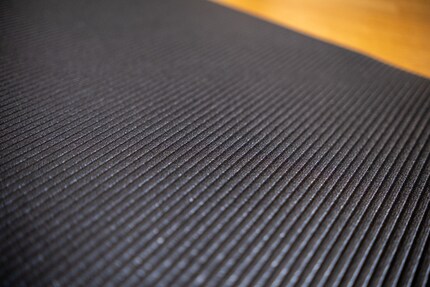
The Sveltus mat is very different from the others tested because one side is made of cork. Yes, you read that right: The material that can make your wine undrinkable. Don't worry, the cork won't make the fitness mat undrinkable. On the contrary: I have rarely felt as comfortable as on the Sveltus mat. Cork is very pleasant to touch and to train on. At 4 millimetres thick, the mat is the thinnest in the test. The back of the mat is made of foam. If you want, you can also train on it. I only used the cork side, if I'm going to use it. With a length of 183 centimetres and a width of 61 centimetres, the cork is about as long as a standard yoga mat. At just under 45 francs, it is in the mid-price segment.
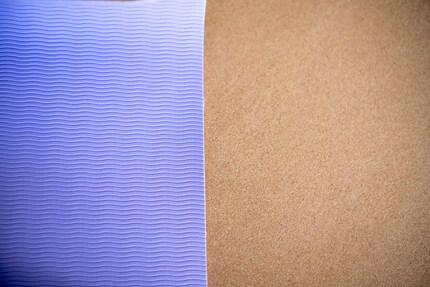
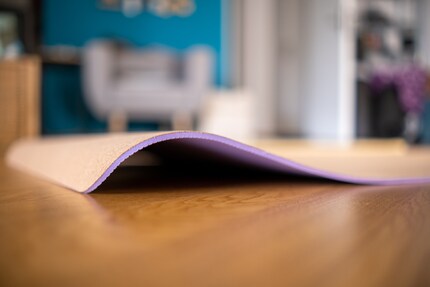
I usually give each product the same amount of space in a comparison test. However, as the Pure2 Improve, Tunturi and Reebok mats are all unsuitable for jumping rope, I'm including them all here. The three mats tested are the cheapest and cost between 30 and 40 francs. If you bought them for rope skipping, you might as well have thrown your money down the drain. After enjoying the performance and comfort of the Blackroll and Harmony, I wouldn't recommend these for other workouts either.
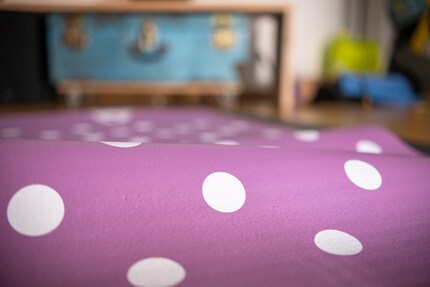
None of the three mats offer anywhere near as good a grip as Blackroll, Harmony, Corona or Cork. Although the Reebok rolls out flat, it moves more than I do during a workout and also forms creases. This wrinkling is not a problem with the other two, but they move a lot more. During my jumps, I can even decide where I want to go. Bathroom I'm coming! As soon as even a drop of sweat gets on the mats, the training finally degenerates into a slide and I slide with my feet on the top as if I were skating. Joking aside: with such poor grip, the risk of injury is very high and for this reason alone, the mats are a no-go for rope skipping.
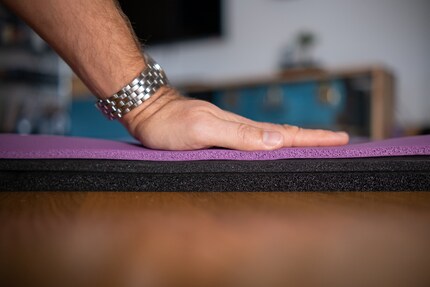
Although the Tunturi is as thick as the Corona at 15 millimetres, the difference in material quality is clearly noticeable. The Corona dampens, the Tunturi lets you through: Even just standing on the mat, I can feel the hard parquet floor under my feet. That's not how cushioning works. The cushioning on the 7 millimetre thick Reebok is slightly better, but the material sticks to my feet and I always lift them slightly when I jump. The 10 millimetre thick mat from Pure2 Improve does all this a bit better, but it's no comparison to the Harmony or Blackroll. What's more, after the first workout, there were already visible marks on the mat from the rope.
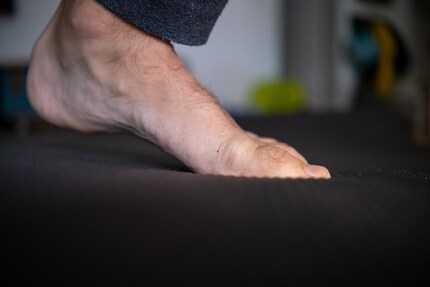
You get what you pay for. This definitely applies to the fitness mats tested. The cheapest ones clearly fail. Only the mat from Blackroll was able to fully convince me. If you are looking for a fitness mat on Galaxus on which you can jump rope without hesitation, the Blackroll is the right one. If you do yoga as well as jumping rope and are not so purist that the 5 millimetre thickness is a killer argument, the Harmony is definitely a good alternative. If you have and need a lot of space for training, the Corona from Airex is also worth considering as it is versatile. As a budget alternative, I can recommend the cork from Sveltus. However, you will have to compromise on grip and cushioning. Pure2 Improve, Tunturi and Reebok are unsuitable for jumping rope and even pose a risk of injury. <p

Siemens EQ700 integral TQ717D03